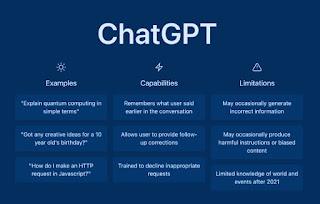ChatGPT: Model of AI
ChatGPT is an artificial intelligence model that is designed to respond to human communication in a natural language format. In this blog, we will dive deeper into what ChatGPT is, how it works, and its potential applications.
What is ChatGPT?
ChatGPT is an AI language model created by OpenAI, a research organization that focuses on developing advanced AI models for various applications. ChatGPT was trained on a massive corpus of text data, including books, articles, and other forms of written communication. This allowed it to learn how to recognize patterns in human language and generate responses that are relevant and appropriate.
How does ChatGPT work?
ChatGPT is based on a neural network architecture that uses deep learning algorithms to process natural language. The model consists of a large number of artificial neurons that are connected in a complex network. When a user inputs a query, the model processes the input and generates a response based on the patterns it has learned from the training data.
One of the key advantages of ChatGPT is that it can generate responses that are both accurate and coherent. This is achieved through a process known as contextualization, which allows the model to understand the meaning of the input in the context of the conversation.
What are the potential applications of ChatGPT?
ChatGPT has many potential applications in a wide range of industries. Some of the most promising applications include:
Customer service: ChatGPT can be used to provide quick and accurate responses to customer queries. This can help businesses to improve their customer service and reduce the workload on their support teams.
Language translation: ChatGPT can be used to translate text from one language to another in real-time. This can be particularly useful for businesses that operate in multiple countries and need to communicate with customers in different languages.
Personal assistants: ChatGPT can be used to create virtual personal assistants that can help users with a wide range of tasks, such as scheduling appointments, sending emails, and making phone calls.
Education: ChatGPT can be used to create interactive educational tools that can help students to learn in a more engaging and effective way. For example, it could be used to provide personalized feedback on written assignments or to create virtual tutors that can answer student questions in real-time.
Marketing: ChatGPT can be used to create personalized marketing campaigns that target specific customer demographics. For example, it could be used to create chatbots that provide product recommendations based on a user's past purchasing history.
The potential applications of ChatGPT are virtually endless, and as the technology continues to evolve, we can expect to see even more exciting applications emerge.
Conclusion
ChatGPT represents a significant advancement in the field of artificial intelligence and natural language processing. Its ability to generate accurate and coherent responses in natural language has many potential applications across a wide range of industries. As the technology continues to evolve, we can expect to see even more exciting applications of ChatGPT and similar models in the future.





Comments
Post a Comment